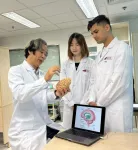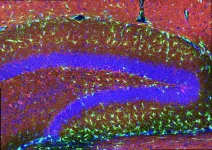Epidemic-economic model provides answers to key pandemic policy questions
Is lockdown an effective response to a pandemic, or would it be better to let individuals spontaneously reduce their risk of infection? These two highly-debated options lead to similar outcomes
2023-11-16
(Press-News.org) University of Oxford news release
Institute of New Economic Thinking
Embargoed until Thursday, 16 November 2023, 16:00 GMT
Is lockdown an effective response to a pandemic, or would it be better to let individuals spontaneously reduce their risk of infection? Research published today suggests these two highly-debated options lead to similar outcomes.
A ground-breaking economic-pandemic model, created by an international team of researchers, addresses some of the key policy debates of the Covid-19 pandemic but it will, in future, enable governments and policymakers to take tough decisions - and assess effective actions.
The modelling, designed by the team, including Oxford experts, has been tested using data from New York city responses to Covid-19 - and it accurately predicted both death rates and the impact on the city's economy of the first wave of the pandemic.
Professor Doyne Farmer, Director of the Complexity Economics Programme at INET Oxford, says the research paper is timely, given the Covid-19 inquiries across the world, 'We are seeing governments across the globe begin their 'moments of reckoning', reviewing the effectiveness of a great variety of policies brought in during Covid-19.
‘According to some, lockdowns were not imposing any trade-off between health and the economy because, if the virus got out of control, the economy would be equally damaged. According to others, letting at-risk individuals spontaneously reduce their risk of infection would have led to the best epidemic and economic outcomes, with no trade-off. These debates have remained contested and unresolved.’
Professor Farmer continues, 'Our quantitative research helps provide evidence-based answers to these questions, suggesting that both lockdowns and spontaneous behaviour change lead to similar trade-offs between health and the economy. Those that claimed that there was no trade-off between health and the economy were not basing their belief in a quantitative model. '
The health-economy trade-off modelling, in the journal Nature Human Behaviour, is the culmination of years of work from an interdisciplinary team of researchers with backgrounds in economics and epidemiology, as well as physics, computer science, and applied mathematics, all united by a shared expertise in complexity science.
The research paper makes a number of conclusions on the effectiveness of government interventions, including:
Both stricter lockdown and strong behaviour change lead to more unemployment and fewer Covid-19 deaths.
They lead to more jobs lost and to more lives saved among low-income workers, while they make less of a difference to high-income workers.
Closing non-customer-facing industries such as manufacturing has little impact on infections but significantly increases unemployment;
Delaying the start of protective measures does little to help the economy and worsens epidemic outcomes in all scenarios;
Dr François Lafond, Deputy Director of INET Oxford's Complexity Economics Programme at the Oxford Martin School, says the model is a big step forward in helping governments prepare for future pandemics, 'Thanks to the level of detail of the model, we could show that low-income workers were affected more by policy decisions, on either side of the health-economy trade-off. Of course, the trade-offs might be different for future crises, but to evaluate these we will need the same kind of interdisciplinary collaboration, building computational models of behaviour to simulate realistic synthetic populations in real time.
Led by Marco Pangallo of CENTAI Institute, the international research group combined economic modelling with epidemic data, to create a holistic tool that can predict health-economy outcomes from pandemic policy decisions. The model's accuracy has been proven in predicting death rates and impact on the economy in the first wave of the pandemic in New York City.
END
ELSE PRESS RELEASES FROM THIS DATE:
2023-11-16
Medical research has shown promising results regarding the potential of gene therapy to cure genetic conditions such as sickle cell disease and the findings of this study, published in Nature Medicine, offer important new insights into processes happening in the body after treatment.
The present study looked at samples from six patients with sickle cell disease who were undergoing gene therapy as part of a major clinical trial at Boston Children’s Hospital. The research brought together an international team of experts, to take a closer look at the genetic changes in the stem cells of patients before and after gene therapy ...
2023-11-16
Depression is one of the most common mental illnesses in the world, but current anti-depressants have yet to meet the needs of many patients. Neuroscientists from City University of Hong Kong (CityU) recently discovered a small molecule that can effectively alleviate stress-induced depressive symptoms in mice by preventing aversive memory formation with a lower dosage, offering a new direction for developing anti-depressants in the future.
“Depression affects millions of individuals worldwide, necessitating more effective treatments. Conventional methods, such as drug therapy with delayed onset of action and psychotherapy, have limitations in yielding satisfactory ...
2023-11-16
DURHAM, N.C. -- Once a favored food of grazing dinosaurs, an ancient lineage of plants called cycads helped sustain these and other prehistoric animals during the Mesozoic Era, starting 252 million years ago, by being plentiful in the forest understory. Today, just a few species of the palm-like plants survive in tropical and subtropical habitats.
Like their lumbering grazers, most cycads have gone extinct. Their disappearance from their prior habitats began during the late Mesozoic and continued into the early Cenozoic Era, punctuated by the cataclysmic asteroid impact and volcanic activity that mark the K-Pg boundary 66 million years ago. However, unlike the dinosaurs, somehow a few groups ...
2023-11-16
WEST LAFAYETTE, Ind. – In the background of image recognition software that can ID our friends on social media and wildflowers in our yard are neural networks, a type of artificial intelligence inspired by how own our brains process data. While neural networks sprint through data, their architecture makes it difficult to trace the origin of errors that are obvious to humans — like confusing a Converse high-top with an ankle boot — limiting their use in more vital work like health care image analysis or research. A new tool developed at Purdue University makes finding those errors as simple as spotting mountaintops from an airplane.
“In a sense, if a neural ...
2023-11-16
Amsterdam, November 16, 2023 – A large case series aimed at understanding the factors underlying Motorist Disorientation Syndrome (MDS) has found that patients experience severe, consistent symptoms comparable to vestibular migraine. Previously there has been speculation that underlying peripheral vestibular hypofunction, when the inner ear part of the balance system is not working properly, contributes to this presentation. However, vestibular deficits were not a consistent feature in the patients studied. The findings have been published in the Journal of Vestibular Research.
In ...
2023-11-16
Rabies virus variants closely related to variants present in White-tufted marmosets (Callithrix jacchus) have been detected in bats in Ceará state, Northeast Brazil.
Rabies is a deadly disease for humans. Its emergence in distinct wildlife species is a potential source of human infection and hence a public health concern. Marmosets are common in forests and conservation units throughout Brazil. In or near urban areas, they are often captured as pets and later abandoned. They have been linked ...
2023-11-16
A rare but potent genetic mutation that alters a protein in the brain’s immune cells, known as microglia, can give people as much as a three-fold greater risk of developing Alzheimer’s disease. A new study by researchers in The Picower Institute for Learning and Memory at MIT details how the mutation undermines microglia function, explaining how it seems to generate that higher risk.
“This TREM2 R47H/+ mutation is a pretty important risk factor for Alzheimer’s disease,” said study lead author Jay Penney, a former postdoc in the MIT lab of Picower Professor Li-Huei ...
2023-11-16
An international research team is the first to use artificial intelligence (AI) analysis to identify dual-purpose target candidates for the treatment of cancer and aging, the most promising of which was experimentally validated. The findings were published in the journal Aging Cell.
Researchers from the University of Oslo, University of Chicago Pritzker School of Medicine, and clinical stage AI-driven drug discovery company Insilico Medicine used Insilico’s AI target discovery engine, PandaOmics, to analyze transcriptomic data derived from ...
2023-11-16
Amyotrophic lateral sclerosis (ALS) is a neurodegenerative disease that affects neurons in the brain and spinal cord causing loss of muscle control. A study by the University of Barcelona has designed a potential therapeutic strategy to tackle this pathology that has no treatment to date. It is a molecular trap that prevents one of the most common genetic ALS-causing peptide compounds, the Poly-GR dipeptide, from causing its toxic effects in the body. The results show that this strategy reduces the death of neurons in patients and in an animal model (vinegar flies) of the disease.
The first authors of this international research study published in the journal Science Advances are ...
2023-11-16
After 40 years of treating metastatic bladder cancer with chemotherapy as a primary treatment, scientists now present a new approach using immunotherapy combinations. The results of not just one, but two studies have been presented at the European Society for Medical Oncology (ESMO) conference in Madrid. The outcomes of these studies are going to revolutionize the landscape of bladder cancer treatment.
Traditionally, cisplatin-based chemotherapy has been the standard treatment for bladder cancer patients who are able to tolerate this drug. However, responses have been limited, and durable outcomes rare. Over the past years, two phase-3 clinical trials studied the effects ...
LAST 30 PRESS RELEASES:
[Press-News.org] Epidemic-economic model provides answers to key pandemic policy questions
Is lockdown an effective response to a pandemic, or would it be better to let individuals spontaneously reduce their risk of infection? These two highly-debated options lead to similar outcomes







